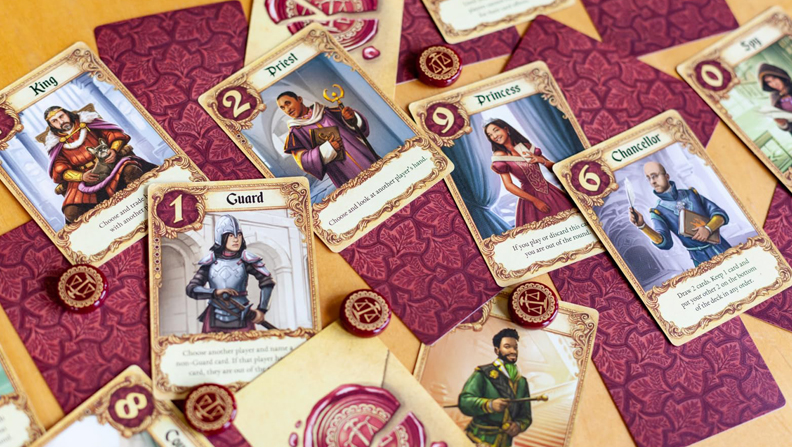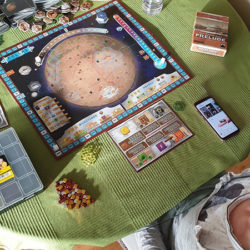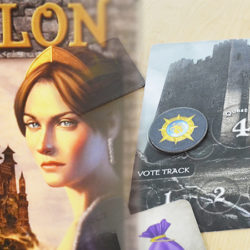
The board game Love Letter by Seiji Kanai pushes players to be decisive while facing uncertain conditions. Playing the game can help people improve their decision making when they have incomplete information about a situation.
If you are not familiar with the game, here is a copy of the rule book. The focus here will be on the four-player classic version that does not include the Chancellor, the Spy, or the sixth Guard.
Elements of Strategy
Love Letter is full of interesting strategic elements.
Each card impacts both how the game plays out and the considerations for what is left in that player’s hand. The deck contains 16 total cards with 8 unique suits, so the game rewards understanding the context of the plays that are made.
To win a four-player game, you must collect four favor tokens. You earn a favor token by winning a round. A round starts with a shuffled deck and one card set aside to be used only if someone plays the Prince on the last turn. Then, everyone is dealt a card. On your turn, you draw a card and play a card. Play continues clockwise.
You win the round by either being the last person remaining or having the highest numbered card when there are no cards remaining in the deck after final play.
When learning the game, it is helpful to study each unique card to understand the implications of playing that card.
1 – Guard (5 cards in game)
The Guard allows you to choose an opponent and name a non-Guard card. If they have the named card, they are knocked out.
On the surface, the Guard is used solely to increase your probability of winning by removing a player from the round. However, it also provides information because when you are unsuccessful it means the card that they have can’t be the card you named.
The Guard might also be used to eliminate cards that you are afraid of. For instance, if you have the Princess and play the Guard, you might name the Prince, ensuring that your opponent will not have a Prince to use against you. However, this isn’t as simple as it might appear, as we’ll see later.
2 – Priest (2 cards in game)
The Priest allows you to look at an opponent’s card.
This can force that player to use the card that was seen. The reason for this is that if you take another turn, you can use a Guard to name the card you saw. However, it is a double-edged sword as it can incentivize the player who was targeted to go after you to protect their information.
3 – Baron (2 cards in game)
The Baron allows you to secretly compare your card with an opponent’s card. The lower valued card is knocked out. If there is a tie, no one is knocked out.
The surviving player lives but has information about their card revealed to everyone, since their card’s value is higher than the eliminated card’s. For example, if you knock out someone who had a Prince, the collective knows that you have a card with a value higher than five.
Playing the Baron makes it more likely that the game will end with one player remaining, rather than the highest numbered card winning.
4 – Handmaid (2 cards in game)
The Handmaid protects you from being targeted by any card abilities until your next turn.
Playing the Handmaid allows you to make it to the final comparison more often, but it doesn’t help in eliminating the other players.
5 – Prince (2 cards in game)
The Prince allows you to choose someone (including yourself) to discard their card and draw a new one.
The Prince is one of the most difficult cards to play with, as the decision to play the prince – and who you play it on – can make or break a game.
It can be used to knock out a Princess from another player, or it can speed up the game ending due to the deck running out.
(As a brief reminder, we play the classic version, which doesn’t include the Chancellor [value 6], hence the jump from 5->7)
7 – King (1 card in game)
The King allows you to swap cards with an opponent.
The King is a card that is not frequently played. It can be very useful for acquiring the Countess or Princess at the end of the game. If the King is played earlier in the game, it can give a lot of information to opponents. This isn’t necessarily a bad thing, depending on how many favor tokens everyone has.
8 – Countess (1 card in game)
The Countess can be played on any turn and does not have an effect when played. The only stipulation for the Countess is if you have both the Countess and either the King or Prince, you are forced to play the Countess.
The Countess seems like a card that would give away a lot of information. That said, the ability to understand when to play the Countess when not obligated to is one of the skills that separates the good Love Letter players from the great Love Letter players.
9 – Princess (1 card in game)
The Princess causes you to lose the game if it is played, or if it is discarded (i.e. due to the Prince)
While the Princess is the highest card, having it early on in the round leads to that player taking forced actions that can be revealing.
A skilled Love Letter player would try to deduce whether a player’s actions were forced or not.
For instance, when an opponent plays a card that makes it seem like they might have the Princess, you would have to question if they would do that if they had any other cards.
Common Love Letters situations to consider when starting out
We play Love Letter in a winner-takes-all way. There’s no difference between coming in second or last. As such, the distribution of favor tokens is crucial when evaluating plays.
Imagine you are the first player to act in a four-player game. Player Two has three tokens (needing only one more token to win), while the rest have zero.
On your turn, you have a Baron and Princess. Who do you want to Baron?
See our response
You would want to Baron Player Two because if they win this round, then you will lose the overall game.
This same logic extends to when you have two Guards and are facing a player with three tokens. But what if you have two Guards on the first turn of the game and none of the players have any tokens?
It is not clear who you should go after. Play your Guard on Player Two like before and if they have a Guard, they’ll likely play it on you, as you are the only other player that they have information on. If you play your Guard on Player Four and they don’t have the card you named, then you incentivize Player Two to Guard them. Be careful though, depending on what you Guard, you might be giving away too much information about your hand as well!
For instance, if you have a Guard and Princess, you may want to name Prince when you Guard to protect yourself from being the target of the Prince later in the game. Similarly, if your second card is of low value – like a Priest or a second Guard — it may make sense to name Baron when you Guard, since your card has lower value.
These types of decisions open the door for exploitative play.
Exploitative play means reacting to players’ behaviors and tendencies to maximize your winnings.
For example, consider a situation where your opponent uses a Guard on another player and names Baron. If you know they are following the above strategy, it is more likely that they have a low card in their hand. Knowing this, you would Baron them on your turn, even when your other card is relatively low, like a Handmaid.
Looking at another situation, if they Guard and name Prince, then on your turn you might be more inclined to Prince them to knock them out if they are holding the Princess. Additionally, the cards you would want to name with Guard could be reduced to just King and Princess.
In order to not be exploited yourself, you need to consider what to do when holding other cards.
You may want to either:
- Consider sometimes naming Baron with your Guard when you have a high value card like the Princess.
- Consider sometimes naming a card other than Baron with your Guard when you have a Priest or a second Guard.
This strategy allows you to do what you want to with the Guard in some cases, while not telegraphing what your hand is.
This is only one example. Here are a few other common situations you may encounter that require some thinking ahead of time:
- If someone plays a King, what card could have been given to the other player?
- Why would someone play a Countess when they aren’t obligated to?
- What cards are you happy to have when playing a Baron?
What is amazing about Love Letter is that a slight adjustment of plays – or token distributions – can change the optimal play for the same set of two cards.
Improving at Love Letter requires realizing that all plays are made with four main considerations:
1) Contextualizing everything that previously happened in the round.
2) Factoring in your card and your path to winning the round.
3) Thinking about how you would play with other cards in a similar situation.
4) Understanding other people’s motivations.
Leveraging Love Letter
The skillsets and concepts learned while improving at Love Letter can be applied to the trading environment.
In order to provide appropriate liquidity and pricing in the markets, traders at Susquehanna must be able to factor in market conditions and the flow of orders throughout the day, and they must be willing to question their assumptions.
The simplicity of Love Letter’s rules and components make it an ideal learning tool to help traders understand how to update their priors based on available information. Understanding how every play is made in the context of what has occurred previously can help improve a person’s decision-making ability.




Subscribe Now
Get each new post sent straight to your inbox